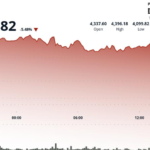Vanguard has established itself as a leader in the investment world by prioritizing long-term investors, viewing them as partners rather than mere clients. This philosophy is reflected in the company’s commitment to offering some of the lowest fees in the industry, as it channels profits back to investors through reduced costs on its funds.
Two particularly appealing options for investors looking to maintain a balanced and long-term strategy are the Vanguard Total Market Index ETF (VTI) and the Vanguard Total Bond Market ETF (BND). Together, these ETFs provide coverage across two major asset classes: equities and fixed-income securities. By allocating 60% of investments to VTI and 40% to BND, investors can create a classic 60/40 portfolio, which is celebrated for its equilibrium of risk and return.
Historically, the 60/40 portfolio has offered a sweet spot for many investors, delivering an average annual return of approximately 8.8%. This allocation not only yields attractive returns but significantly lowers the chances of substantial losses during market downturns. Historical data illustrates that portfolios heavier on stocks tend to experience higher volatility, while even modest allocations to bonds can help mitigate risks and dampen the severity of poor annual returns.
The Vanguard Total Stock Market ETF, known for its simplicity, tracks the CRSP US Total Market Index, which encompasses all U.S. equities traded on major exchanges. This ETF comprises over 3,500 stocks and is designed to provide broad exposure to the U.S. market. The fund prioritizes investments in larger companies based on market capitalization, with its top five holdings currently featuring industry giants like Nvidia, Microsoft, and Apple. This structure allows investors to gain significant exposure to the largest and most impactful firms in the country.
Performance-wise, VTI has consistently demonstrated solid returns, closely mirroring its benchmark index. With an extremely low expense ratio of just 0.03%, costs are minimal—amounting to approximately $0.02 in management fees for every $60 invested.
On the other hand, the Vanguard Total Bond Market Fund provides investors access to a diverse range of U.S. dollar-denominated, taxable investment-grade bonds. This fund includes high-quality debt issued by various entities, including government securities and corporates, while excluding municipal and junk bonds. Holding nearly 11,400 bonds, this ETF averages over eight years in maturity across its portfolio.
Bonds serve multiple purposes in an investment strategy: they offer fixed income through interest payments—currently yielding over 4% for BND—and contribute to overall portfolio diversification, reducing risk. Nevertheless, returns on bonds have been relatively muted compared to equities, particularly in recent years, driven by historically low interest rates.
Much like its equity counterpart, BND achieves a strong correlation with its benchmark and comes with an equally low expense ratio of 0.03%, leading to only $0.01 in fees for every $40 invested. This allows investors to retain more of the income generated by their bond holdings.
By combining these two Vanguard ETFs, investors can create a nuanced investment strategy that balances potential growth from stocks with the stability and income derived from bonds. Investing in these funds offers a straightforward “set-and-forget” approach, making it an attractive choice for those seeking a long-term, hands-off investment strategy.







